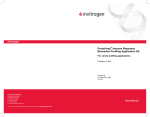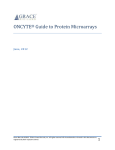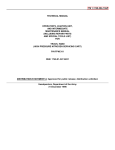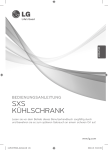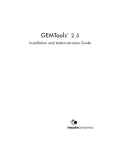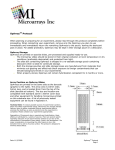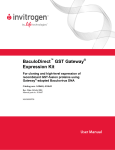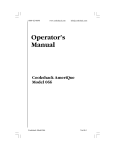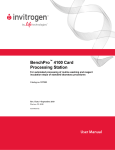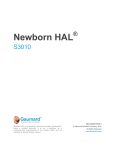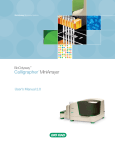Download User Manual - Thermo Fisher Scientific
Transcript
ProtoArray® Protein Microarray PPI Kits for V5 Epitope-Tagged Proteins For detecting protein-protein interactions (PPI) using a human or yeast protein microarray and a V5 epitope-tagged protein Catalog nos. PA013, PA0121013, and PAH0524013 Version D 18 October 2006 25-0785 Corporate Headquarters Invitrogen Corporation 1600 Faraday Avenue Carlsbad, CA 92008 T: 1 760 603 7200 F: 1 760 602 6500 E: [email protected] For country-specific contact information visit our web site at www.invitrogen.com User Manual ii Table of Contents Table of Contents ................................................................................................................................................. iii Kit Contents and Storage .................................................................................................................................... iv Accessory Products............................................................................................................................................. vii Introduction ................................................................................................................... 1 Overview.................................................................................................................................................................1 Description of Kit Components ...........................................................................................................................4 ProtoArray® Human Protein Microarray ...........................................................................................................6 ProtoArray® Yeast Proteome Microarray ...........................................................................................................9 ProtoArray® Control Protein Microarray .........................................................................................................11 Experimental Overview ......................................................................................................................................14 Methods ....................................................................................................................... 17 Preparing the Protein Probe ...............................................................................................................................17 Probing the ProtoArray® Control Protein Microarray....................................................................................18 Probing the ProtoArray® Human or Yeast Microarrays.................................................................................24 Scanning Arrays...................................................................................................................................................27 Data Acquisition and Analysis ..........................................................................................................................30 Expected Results ..................................................................................................................................................34 Troubleshooting ...................................................................................................................................................38 Appendix...................................................................................................................... 41 Technical Support ................................................................................................................................................41 Product Qualification ..........................................................................................................................................42 Purchaser Notification ........................................................................................................................................43 References .............................................................................................................................................................45 iii Kit Contents and Storage Types of Kits This manual is supplied with the following kits. Product Catalog no. ProtoArray® Human Protein Microarray PPI Complete Kit v4.0 PAH0524013 for V5 epitope-tagged proteins ProtoArray® Yeast Proteome Microarray PPI Complete Kit v1.1 PA0121013 for V5 epitope-tagged proteins ProtoArray® Protein-Protein Interaction Application Kit for V5 epitope-tagged proteins Kit Components PA013 The ProtoArray® PPI Kits for Epitope-Tagged Proteins include the following components. For a detailed description of the contents of each component, see pages v-vi. Note: Catalog nos. PAH0524013 and PA0121013 include two ProtoArray® Human Protein or Yeast Proteome Microarrays, as appropriate and one ProtoArray® Control Protein Microarray. Component Catalog no. PAH0524013 PA0121013 ® ProtoArray Human Protein Microarray nc v4.0 √ √ ® ProtoArray Yeast Proteome Microarray nc v1.1 ProtoArray Control Protein Microarray nc v4.0 √ √ Array Control Protein √ √ Anti-V5-Alexa Fluor® 647 Antibody √ √ √ ® √ √ √ ® √ √ √ ® ProtoArray PPI Buffer Module A ProtoArray PPI Buffer Module B Shipping and Storage PA013 The components included in the ProtoArray® PPI Kits for Epitope-Tagged Proteins are shipped as detailed below. Upon receipt, store as indicated. All kit components are stable for 12 months when stored properly. Shipping Storage ® Components Blue ice -20°C ® Blue ice -20°C ® ProtoArray Control Protein Microarray nc v4.0 Blue ice -20°C Array Control Protein Dry ice -20°C ProtoArray Human Protein Microarray nc v4.0 ProtoArray Yeast Proteome Microarray nc v1.1 ® Anti-V5-Alexa Fluor 647 Antibody Blue ice 4°C ® Dry ice -20°C ® Blue ice 4°C ProtoArray PPI Buffers Module A ProtoArray PPI Buffers Module B Continued on next page iv Kit Contents and Storage, Continued ProtoArray® Human or Yeast Microarrays Each ProtoArray® Microarray PPI Complete Kit contains mailers with the following ProtoArray® Microarrays: • Human Kit (Catalog no. PAH0524013): Contains two ProtoArray® Human Protein Microarrays nc v4.0 • Yeast Kit (Catalog no. PA0121013): Contains two ProtoArray® Yeast Proteome Microarrays nc v1.1 Store the microarrays at -20°C. For details on array specifications, see pages 6-11. ProtoArray® Control Reagents Each ProtoArray® Microarray PPI Complete Kit includes the following control reagents. Store the microarray and Array Control Protein at -20°C. Item ® Composition Amount ProtoArray Control Protein Microarray nc v4.0 -- 1 array Array Control Protein (V5-tagged, biotinylated yeast Calmodulin kinase) 0.5 mg/ml in phosphatebuffered saline (PBS), pH 7.4 40 µl For details on array specifications, see page 11. For information about the Array Control Protein, see page 19. Continued on next page v Kit Contents and Storage, Continued Anti-V5-Alexa Fluor® 647 Antibody The ProtoArray® Microarray PPI Complete Kits and the ProtoArray® ProteinProtein Interaction Application Kit each contain 1 tube of Anti-V5-Alexa Fluor® 647 Antibody with the following specifications: • Concentration: 0.5 mg/ml in 0.1 M NaCl, 0.1 M sodium phosphate, pH 7.5 with 2 mM sodium azide • Amount supplied: 80 µl Store at 4°C. Protect the Anti-V5-Alexa Fluor® 647 Antibody from exposure to light. Avoid repeated freezing and thawing of the antibody as this may result in loss of activity. ProtoArray® PPI Buffer Module A The ProtoArray® PPI Buffer Module A includes the following reagents. Store at -20°C. Note: The amount of reagents supplied is sufficient to perform 4 microarray screening experiments. Item ProtoArray® PPI Buffer Module B Composition Amount Bovine Serum Albumin (BSA) 30% BSA in 0.85% NaCl 30 ml DTT 1 M DTT in deionized water 400 µl The ProtoArray® PPI Buffer Module B includes the following reagents. Store at 4°C. Note: The amount of reagents supplied is sufficient to perform 4 microarray screening experiments. Item Amount ProtoArray® Blocking Buffer (10X) 10X PBS, pH 7.4 1% Tween 20 12 ml ProtoArray® Probe Buffer (5X) 5X PBS, pH 7.4 0.25% Triton X-100 25% Glycerol 175 ml MgCl2 1 M MgCl2 in deionized water 4 ml HybriSlip Cover Slip 60 mm x 22 mm, RNase-free 5 cover slips per pack Array Chambers -- 2 ™ vi Composition Accessory Products Additional Products The table below lists additional products available separately from Invitrogen. For more information about these products, refer to our web site (www.invitrogen.com) or call Technical Support (page 41). Product Quantity Catalog no. ProtoArray® Reagents ProtoArray® Human Protein Microarray nc v4.0 1 array PAH052401 ProtoArray® Yeast Proteome Microarray nc v1.1 1 array PA012101 ® 1 array PA1007 ® 1 kit PA014 ProtoArray Control Protein Microarray nc v4.0 ProtoArray Protein-Protein Interaction Buffer Modules ® ProtoArray Human Protein Microarray PPI Complete Kit v4.0 1 kit for biotinylated proteins PAH0524011 ProtoArray® Yeast Proteome Microarray PPI Complete Kit v1.1 1 kit for biotinylated proteins PA0121011 ProtoArray® Protein-Protein Interaction Application Kit for biotinylated proteins 1 kit PA011 ProtoArray® Mini-Biotinylation Kit 1 kit AL-01 ® ProtoArray Human Protein Microarray KSI Complete Kit v4.0 1 kit for kinase substrate identification PAH0524065 ProtoArray® Yeast Proteome Microarray KSI Complete Kit v1.1 1 kit for kinase substrate identification PA0121065 ProtoArray® Kinase Substrate Identification Application Kit 1 kit PA015 ® 1 array PAH052406 ® 1 array PA012106 ® 1 array PA1002 ® 1 kit PA016 ProtoArray Human Protein Microarray mg v4.0 ProtoArray Yeast Proteome Microarray mg v1.1 ProtoArray Control Protein Microarray mg v4.0 ProtoArray Immune Response Biomarker Profiling Application Kit Continued on next page vii Accessory Products, Continued Product Quantity Catalog no. Reagents Anti-V5 Antibody 50 µl R960-25 Anti-V5-HRP Antibody 50 µl R961-25 Anti-V5-AP Antibody 50 µl R962-25 ® 1 kit WB7103 ® WesternBreeze Chemiluminescent Kit-Anti-Mouse 1 kit WB7104 Nitrocellulose (0.45 µm) 20 membrane/filter paper sandwiches LC2001 1 kit PQ10002-01 1 kit PQ10001-01 WesternBreeze Chromogenic Kit-Anti-Mouse ProQuest™ Two-Hybrid System ™ ® ProQuest Two-Hybrid System with Gateway Technology Pre-Cast Gels and Pre-made Buffers A variety of pre-cast gels including NuPAGE® Novex® Pre-cast Gels and premade buffers for gel electrophoresis are available from Invitrogen. For details on these products, visit our website at www.invitrogen.com or contact Technical Support 41). Vectors A large selection of vectors is available from Invitrogen to express your protein of interest with an N- or C-terminal V5-tag. For more details on the vectors available, visit www.invitrogen.com or call Technical Support (page 41). viii Introduction Overview Introduction The ProtoArray® Human Protein and Yeast Proteome Microarray PPI (proteinprotein interaction) Kits for Epitope-Tagged Proteins allow rapid and efficient detection of human or yeast protein-protein interactions using a V5 epitopetagged protein probe of interest. The ProtoArray® Human Protein Microarray nc contains thousands of purified human proteins, while the ProtoArray® Yeast Proteome Microarray nc contains > 4000 purified yeast proteins from Saccharomyces cerevisiae. In both cases, the proteins are printed in duplicate on a nitrocellulose (nc)-coated glass slide. See the next page for an overview of the system. ProtoArray® Microarray PPI Applications The ProtoArray® Human Protein and Yeast Proteome Microarrays allow you to: V5 Epitope Tag • Detect novel protein-protein interactions • Validate previously observed protein-protein interactions • Confirm positive interactions using the identified interacting protein on the array as a probe in reciprocal experiments • Test various experimental conditions for your protein-protein interactions The V5 epitope tag is a 14 amino acid (GKPIPNPLLGLDST) epitope derived from the P and V proteins of the paramyxovirus, SV5 (Southern et al., 1991). In this application, you will express the V5 epitope tag as a fusion to your protein of interest, and use the tag to detect your protein with a fluorescently-labeled Anti-V5 Antibody. Note: Anti-V5 Antibodies are also available from Invitrogen (page vii) for use in Western analysis to detect recombinant proteins containing the V5 epitope. Continued on next page 1 Overview, Continued System Overview To use the ProtoArray® Human Protein or Yeast Proteome Microarray PPI Kits, you will: • Express your protein of interest as a fusion protein containing an N- or C-terminal V5 epitope tag, and purify the fusion protein using a method of choice. • Use the supplied Array Control Protein to probe the ProtoArray® Control Protein Microarray nc to verify probing conditions and the background level. • Probe the ProtoArray® Human Protein or Yeast Proteome Microarray nc, with the V5-tagged protein probe to detect protein-protein interactions. The ProtoArray® detection protocol includes instructions to block the array, probe the array with your protein probe, wash to minimize non-specific interactions, detect interactions using the Anti-V5-Alexa Fluor® 647 Antibody, wash to remove unbound antibody, dry, scan the array to view results, acquire the array image, and analyze data (see figure below). For a detailed experimental workflow, see page 16. 00027734 Block (1 hr), add protein probe with V5 tag (90 min) Advantages Wash (10 min), add ® Anti-V5-Alexa Fluor 647 Antibody for detection (30 min) Wash, dry, and scan (1 hr) Using the ProtoArray® Human Protein or Yeast Proteome Microarray PPI Kits to detect protein-protein interactions offers the following advantages: • Provides a simple, rapid, and efficient method to identify protein interactions within a day • Includes qualified buffers and detection reagents for probing, eliminating the need to prepare reagents • Allows screening of your protein of interest against thousands of human proteins or yeast proteins • Provides sensitive, stable, fluorescence detection using the Alexa Fluor® 647 dye • Built-in controls are printed on each array to control for background and detection • Arrays are compatible with most commercially available fluorescence microarray scanners Continued on next page 2 Overview, Continued The reagents and protocols included with the ProtoArray® Human Protein or Yeast Proteome Microarray PPI Kits support probing microarrays with a protein probe containing an N- or C-terminal V5 tag. Our studies have shown that proteins with other epitope tags such as FLAG, myc, and HA (hemagglutinin) can be used as probes against the ProtoArray® Human Protein or Yeast Proteome Microarray nc using an appropriate labeled antibody. To detect the protein-protein interaction, use a labeled antibody specific for the tag. The antibody can be directly labeled with a fluorescent dye such as Alexa Fluor® 647 or labeled with a secondary antibody conjugated to a fluorescent dye such as Alexa Fluor® 647. Make sure that direct labeling of the antibody does not affect antibody activity. • Since most of the human and yeast proteins printed on the microarray contain a GST (Glutathione-S-Transferase) fusion tag and some proteins also contain polyhistidine (6x) tag, do not use an anti-GST antibody or antipolyhistidine antibody for detecting interactions on a ProtoArray® Human or Yeast Protein Microarray nc. We strongly recommend that you probe the ProtoArray® Human or Yeast Protein Microarray nc with only your detection reagent to detect signals resulting due to interactions between the detection reagent and proteins printed on the array. • The ProtoArray® Microarrays are not compatible for use with Alexa Fluor® 555 or Cy3™ dyes. Use of these fluorescent dyes results in high background on the array as the nitrocellulose surface has high intrinsic fluorescence at the wavelength used to visualize Alexa Fluor® 555 or Cy3™ dyes. Important Purpose of the Manual This manual provides the following information: • An overview of the ProtoArray® Human Protein, Yeast Proteome, and Control Protein Microarrays • Instructions to probe the ProtoArray® Microarray with your protein probe • Guidelines to perform data analysis • Expected Results and Troubleshooting 3 Description of Kit Components Components of the ProtoArray® PPI Kits ProtoArray® Human Protein and Yeast Proteome Microarrays The ProtoArray® Human Protein or Yeast Proteome Microarray PPI Complete Kits for Epitope-Tagged Proteins include the following major components: • The ProtoArray® Human Protein or Yeast Proteome Microarray, a highdensity protein microarray that allows you to screen your protein of interest (protein probe) against thousands of human proteins or the Saccharomyces cerevisiae proteome, respectively • The ProtoArray® Control Protein Microarray and the Array Control Protein for verification of the probing conditions and background levels • The ProtoArray® PPI Buffer Modules A and B contain pre-made, qualified reagents for performing the blocking and washing steps during probing • The Anti-V5-Alexa® Fluor 647 Antibody for detection The ProtoArray® Human Protein and Yeast Proteome Microarrays are highdensity protein microarrays containing human or S. cerevisiae proteins, respectively. The ProtoArray® technology is based on the yeast protein microarray technology developed by Zhu et al., 2001 to detect molecular interactions with proteins. Each human or S. cerevisiae open reading frame (ORF) is expressed as an Nterminal GST (Glutathione-S-Transferase) fusion protein, purified, and printed in duplicate on a nitrocellulose-coated glass slide. The use of nitrocellulose as a surface to print the arrays ensures maximum utility for protein assays since the nitrocellulose surface is known to be compatible with a variety of protein functions (Espejo et al., 2002; Kukar et al., 2002; Michaud et al., 2003). The nitrocellulose coating is thin and does not interfere with scanning of the array. Each ProtoArray® Microarray PPI Complete Kit includes two microarrays to allow you to assay for protein interactions using different experimental conditions or two distinct proteins. Using a labeled protein probe, you can screen against the human or S. cerevisiae proteins within a day to identify protein-protein interactions. For array specifications and more details on how the human and yeast proteins are prepared, see pages 6-9. ProtoArray® Control Protein Microarray The ProtoArray® Control Protein Microarray nc contains human and yeast protein interactors and various controls printed on a nitrocellulose-coated glass slide. Use the Control Microarray to validate the assay prior to probing the ProtoArray® Human Protein or Yeast Proteome Microarray nc. One control array is included in each kit; probe with the Array Control Protein supplied in the kit (V5-tagged,biotinylated yeast calmodulin kinase) to validate assay conditions and demonstrate a known protein-protein interaction between yeast calmodulin kinase (Array Control Protein) and yeast calmodulin (Cmd1p-Ybr109C) on the array. For specifications and more details on the ProtoArray® Control Protein Microarray, see page 11. Continued on next page 4 Description of Kit Components, Continued ProtoArray® PPI Buffers Module The ProtoArray® PPI Buffers Module A and B include qualified reagents used in the blocking, washing, and detection steps during probing of the ProtoArray® Microarrays. The pre-made buffers provide consistent results and eliminate the time required to prepare reagents. ProtoArray® PPI Buffers Module B includes HybriSlip™ cover slips that hold a small reagent volume to minimize the amount of valuable probe used and prevent evaporation of reagents. Array Chambers are also included in the module for washing the microarrays. Alexa Fluor® 647 Detection The high sensitivity, low background, signal stability, and commercial availability of fluorescence microarray scanners make fluorescence detection the preferred method for detecting protein-protein interactions on microarrays. The ProtoArray® Human Protein and Yeast Proteome Microarray PPI Kits include the Anti-V5-Alexa Fluor® 647 Antibody (i.e. Mouse Anti-V5 Antibody conjugated to Alexa Fluor® 647) for detection of the V5-tagged protein probe. The Alexa Fluor® 647 fluorophore is brighter and more stable than other commercially available dyes such as Cy™ Dyes and is more sensitive for detecting interactions on protein arrays. We have demonstrated that detection with Alexa Fluor® 647 produces approximately 2-fold higher signal/background ratios than Cy5™ detection. ProtoArray® PPI Application Kit The ProtoArray® Protein-Protein Interaction Application Kit includes ProtoArray® PPI Buffer Modules A and B, and the Anti-V5-Alexa Fluor® 647 Antibody only. You will need to obtain a ProtoArray® Human Protein or Yeast Proteome Microarray nc separately from Invitrogen before performing a microarray screening experiment. ProtoArray® Central Portal The ProtoArray® Central Portal at www.invitrogen.com/protoarray provides a web-based user interface to access ProtoArray® specific information including online tools, applications, and other resources. You will also use the portal to retrieve ProtoArray® Lot Specific information (see page 30), which is required for analysis of the array data and identification of statistically significant interactions. ProtoArray® Prospector The ProtoArray® Prospector software quickly analyzes the microarray data acquired from the image acquisition software and easily identifies significant hits, saving you time and effort. In addition, the software has features that allow you to modify the analysis method and compare data obtained from different microarrays. The ProtoArray® Prospector software and manual are available free-of-charge to ProtoArray® users, and are accessible online at the ProtoArray® Central Web Portal. To download the ProtoArray® Prospector software and manual, go to www.invitrogen.com/protoarray, and click on Online Tools tab. 5 ProtoArray® Human Protein Microarray Introduction The ProtoArray® Human Protein Microarray nc is a high-density protein microarray containing thousands of human proteins. Each human open reading frame (ORF) is expressed as an N-terminal GST fusion protein, purified, and printed in duplicate on a nitrocellulose-coated glass slide. This section provides details about the human protein microarray including array specifications and preparation of proteins. Note: The ProtoArray® Human Protein Microarray PPI Complete Kit includes 2 ProtoArray® Human Protein Microarrays. Human Protein Microarray Specifications The specifications for the ProtoArray® Human Protein Microarray nc are listed below. Dimensions: 1 inch x 3 inch (25 mm x 75 mm) Material: Glass slide coated with nitrocellulose membrane Membrane Size: 20 mm x 60 mm Membrane Properties: Thickness: 15-20 µm; Pore Size: 0.2 µm Each microarray has a barcode for tracking samples. The barcode is also used to retrieve array specific information from the ProtoArray® Central Portal (see page 30). Array Specifications The array specifications for the ProtoArray® Human Protein Microarray nc are listed below. The proteins on the microarray are printed in 48 subarrays and are equally spaced in vertical and horizontal directions. For details on the subarray layout, and human protein and control spots on the ProtoArray® Human Protein Microarray nc, go to the ProtoArray® Central Portal at www.invitrogen.com/protoarray. Total Subarrays: 48 (4 columns x 12 rows) Subarray Size: 4400 µm x 4400 µm Subarray Dimensions: 20 rows x 20 columns Median Spot Diameter: ~150 µm Spot Center to Center Spacing: 220 µm Distance Between Subarrays: 100 µm Replicates per Sample: 2 Total human protein spots on v4.0 ~8000* ® *Refer to ProtoArray Central Portal for exact number of human proteins printed on the microarray. Continued on next page 6 ProtoArray® Human Protein Microarray, Continued Array Content The majority of human protein collection is derived from the human Ultimate™ ORF (open reading frame) Clone Collection available from Invitrogen (see http://orf.invitrogen.com for more information). Each Ultimate™ ORF Clone is full insert sequenced and is guaranteed to match the corresponding GenBank® amino acid sequence. Some of the human proteins printed on the array represent the human protein kinase collection derived from full insert sequenced clones but are not Ultimate™ ORF Clones. Some of the kinases from the kinase collection have been cloned as catalytic domains rather than full-length proteins. About 250 proteins printed on the array are derived from the purified protein kinase collection available from Invitrogen. Approximately 25 proteins, peptides, and nucleic acids that have been demonstrated to be antigens in a variety of autoimmune diseases are also printed on the array. For accession number and amino acid sequence for each protein as well as information on peptides and nucleic acids printed on the array, download the Protein Information File from www.invitrogen.com/protoarray as described on page 30. Expression and Purification of Human Proteins Almost all clones used to generate the human protein collection are entry clones consisting of a human ORF cloned into a Gateway® entry vector. Each entry clone is subjected to a LR recombination reaction with a Gateway® destination vector to generate an expression clone. The expression clone is then used to express the protein (as an N-terminus GST-fusion protein in some clones) using the Bac-to-Bac® Baculovirus Expression System available from Invitrogen. For more information on the Bac-to-Bac® Baculovirus Expression System, visit www.invitrogen.com. The LR reaction mix obtained after performing the LR reaction is transformed into competent DH10Bac™ E. coli to generate a recombinant bacmid. The high molecular weight recombinant bacmid DNA is isolated and transfected into Sf9 insect cells to generate a recombinant baculovirus that is used for preliminary expression experiments. After the baculoviral stock is amplified, the high-titer stock is used to infect Sf9 insect cells for expression of the recombinant protein of interest. After verifying that each clone expresses a protein of the expected molecular weight by western blotting, the proteins are expressed and purified using highthroughput procedures. The expressed proteins are purified by affinity chromatography under conditions optimized to obtain maximal protein integrity, function, and activity. Approximately 5000 human proteins printed on the ProtoArray® Human Protein Microarray nc v4.0 were also present on the previous version of the product, ProtoArray® Human Protein Microarray nc v3.0. However, not all proteins printed on ProtoArray® Human Protein Microarray nc v3.0 are also printed on ProtoArray® Human Protein Microarray nc v4.0. To obtain a list of ProtoArray® Microarray nc v3.0 human proteins that are not printed on ProtoArray® Microarray nc v4.0, contact Technical Support (page 41). Continued on next page 7 ProtoArray® Human Protein Microarray, Continued Controls Various proteins and controls are printed on each ProtoArray® Human Protein Microarray to allow you to verify background and detection conditions during probing. For details, see page 12. Printing the Human ProtoArray® The purified human proteins are printed on nitrocellulose-coated slides in a dust-free, temperature, and humidity controlled environment to maintain consistent quality of the microarrays. The arrays are printed using an automated process on an arrayer that is extensively calibrated and tested for printing ProtoArray® Microarrays. Maintaining Stringent Quality Control ProtoArray® Human Protein Microarrays are produced using rigorous production and quality control procedures with an integrated data management system to ensure consistent results with every array and maximize inter-and intra-lot reproducibility. Pre-Printing Quality Control Prior to production, the arrayer and supporting components are tested and adjusted to production specifications. To maintain protein stability and function, arrays are printed at 6ºC under controlled environmental conditions. Post-Printing Quality Control After production each microarray is visually inspected for obvious defects that could interfere with the experimental results. To control for the quality of the printing process, several microarrays from each lot are probed with an anti-GST antibody. Since the proteins contain a GST fusion tag, probing the microarrays with an anti-GST antibody allows identification of irregular spot morphology or missing spots. The arrays are functionally qualified by probing control proteins to detect the appropriate protein-protein interactions. For detailed product qualification, see page 42. Detecting Reciprocal Interactions ProtoArray® Human Protein Microarrays are ideal for detecting reciprocal interactions since the microarrays are manufactured under highly controlled conditions to ensure maximum protein function. Once you have identified a positive interaction using the ProtoArray® Human Protein Microarray nc, use the identified interacting protein from the array as a probe for probing another human microarray. For example, perform an initial probing with calmodulin as a probe with a ProtoArray® Human Protein Microarray nc to detect the interacting protein, calmodulin kinase. Then perform the reciprocal interaction with another human microarray using calmodulin kinase as the probe to detect the interacting protein, calmodulin. The ability to observe reciprocal interactions indicates that the proteins maintain a proper folded state on the array. 8 ProtoArray® Yeast Proteome Microarray Introduction The ProtoArray® Yeast Proteome Microarray nc is a high-density protein microarray containing the majority of proteins from S. cerevisiae. Each S. cerevisiae open reading frame (ORF) is expressed as an N-terminal GST-6xHis fusion protein, purified, and printed in duplicate on a nitrocellulose-coated glass slide. This section provides details about the yeast proteome microarray including array specifications and preparation of proteins. Note: The ProtoArray® Yeast Proteome Microarray PPI Complete Kit includes 2 ProtoArray® Yeast Proteome Microarrays. Yeast Proteome Microarray Specifications The specifications for the ProtoArray® Yeast Proteome Microarray nc are listed below. Dimensions: 1 inch x 3 inch (25 mm x 75 mm) Material: Glass slide coated with nitrocellulose membrane Membrane Size: 20 mm x 60 mm Membrane Properties: Thickness: 15-20 µm; Pore Size: 0.2 µm Each microarray has a barcode for tracking samples. The barcode is also used to retrieve array specific information from the ProtoArray® Central Portal (see page 30). Array Specifications The array specifications for the ProtoArray® Yeast Proteome Microarray nc are listed below. The proteins on the microarray are printed in 48 subarrays and are equally spaced in vertical and horizontal directions. For details on the subarray layout, and yeast protein and control spots on the ProtoArray® Yeast Proteome Microarray nc, go to the ProtoArray® Central Portal at www.invitrogen.com/protoarray. Note: The subarray layout and controls are different in ProtoArray® Yeast Proteome Microarray nc v1.1 as compared to the previously available ProtoArray® Yeast Proteome Microarray nc v1.0. Total Subarrays: 48 (4 columns x 12 rows) Subarray Size: 4400 µm x 4400 µm Subarray Dimensions: 16 rows x 20 columns Median Spot Diameter: ~150 µm Spot Center to Center Spacing: 220 µm Distance Between Subarrays: 100 µm Replicates per Sample: 2 Total Yeast Proteins Spots on v1.1: >4000* ® *Refer to ProtoArray Central Portal for exact number of human proteins printed on the microarray. Continued on next page 9 ProtoArray® Yeast Proteome Microarray, Continued Preparing Yeast Proteins The yeast proteome collection is derived from the S. cerevisiae clone collection of 5800 yeast ORFs (Zhu et al., 2001). Each S. cerevisiae open reading frame (ORF) is expressed as an N-terminal GST-6xHis fusion protein in the yeast expression vector pEG-KG (Mitchell et al., 1993). The identity of each clone is verified using 5’-end sequencing and the expression of GST-tagged fusion protein by each clone is confirmed with Western immunodetection using an anti-GST antibody. The proteins are then expressed and purified using high-throughput procedures. Briefly yeast stocks are initiated in growth media, protein expression is induced with galactose, and cell lysates prepared. The proteins are purified using glutathione affinity chromatography, eluted, and purified proteins are used to spot the proteome microarray. Printing the Yeast ProtoArray® The purified yeast proteins are printed on nitrocellulose-coated slides in a dustfree, temperature, and humidity controlled environment to maintain consistent quality of microarrays. The arrays are printed using an automated process on an arrayer that is extensively calibrated and tested for printing ProtoArray® Microarrays. Controls Various proteins and controls are printed on each ProtoArray® Yeast Proteome Microarray to allow you to verify background and detection conditions during probing. For details, see page 12. Detecting Reciprocal Interactions The ProtoArray® Yeast Proteome PPI Microarrays are ideal for detecting reciprocal interactions since the microarrays are manufactured under highly controlled conditions to ensure maximum protein function. Once you have identified a positive interaction using the ProtoArray® Yeast Proteome Microarray nc, use the identified interacting protein from the array as a probe for to probe another ProtoArray® Yeast Proteome Microarray nc to confirm the reciprocal interaction. For examples of reciprocal interactions, see page 37. Maintaining Stringent Quality Control 10 The ProtoArray® Yeast Proteome Microarrays are produced using the same rigorous production and pre-printing and post-printing quality control procedures used to produce the human protein microarrays (see page 8). For detailed product qualification, see page 42. ProtoArray® Control Protein Microarray Introduction The ProtoArray® Control Protein Microarray nc contains protein interactors and various controls printed on a nitrocellulose-coated glass slide. The Control Protein Microarrays allow you to validate probing procedures prior to probing the ProtoArray® Human Protein or Yeast Proteome Microarray nc. Details about the ProtoArray® Control Protein Microarray are described in this section. Control Microarray Specifications The specifications for the ProtoArray® Control Protein Microarray are listed below. Dimensions: 1 inch x 3 inch (25 mm x 75 mm) Material: Glass slide coated with nitrocellulose membrane Membrane Size: 20 mm x 60 mm Membrane Properties: Thickness: 15-20 µm; Pore Size: 0.2 µm Each microarray has a barcode for tracking samples. The barcode is also used to retrieve array specific information from the ProtoArray® Central portal (see page 30). Control Array Specifications The control array specifications are listed below. The proteins on the microarray are printed in 48 subarrays and are equally spaced in vertical and horizontal directions. For details on the subarray layout and control protein spots, go to the ProtoArray® Central portal at www.invitrogen.com/protoarray. Total Subarrays: 48 (4 columns x 12 rows) Subarray Size: 4400 µm x 4400 µm Subarray Dimensions: 8 rows x 20 columns Median Spot Diameter: ~150 µm Spot Center to Center Spacing: 220 µm Distance Between Subarrays: 100 µm Replicates per Sample: 2 Continued on next page 11 ProtoArray® Control Protein Microarray, Continued Controls Printed on Each ProtoArray® Microarray Various proteins and controls are printed on each ProtoArray® Human Protein, Yeast Proteome, and Control Protein Microarray to allow you to verify reagents, background, and detection conditions used during probing. The table below lists the controls printed on each ProtoArray® Microarray. Protein Function Control Spots required for PPI Data Analysis Alexa Fluor® Antibody (Rabbit anti-mouse IgG Antibody labeled with Alexa Fluor® 647, Alexa Fluor® 555, and Alexa Fluor® 488) Serves as a positive control for fluorescence scanning and for orientation of the microarray image. Bovine Serum Albumin (BSA) A negative control for non-specific protein interactions. Biotinylated Anti-mouse Antibody A positive control for interaction with streptavidin-labeled detection reagent. V5 Control Protein (biotinylated, V5-tagged control protein) A positive control for detection with the Anti-V5-Alexa Fluor® 647 Antibody. Human IgG Protein Gradient A positive control for the immune response serum profiling application. Interacts with Alexa Fluor® 647 goat anti-human IgG. Anti-Human IgG Antibody Gradient (goat anti-human IgG) A positive control for the immune response serum profiling application. Interacts with serum IgG antibodies which are then bound by Alexa Fluor® 647 goat anti-human IgG. Yeast calmodulin (Cmd1p) A positive control for protein-protein interaction application and interacts with the Array Control Protein. GST Protein Gradient Serves as a negative control and signals are used by ProtoArray® Prospector software for background and statistical significance calculations. Control Spots NOT required for PPI Data Analysis 12 Fiduciary Kinases Kinases autophosphorylate and produce fiduciary (marker) signals which are used for orientation of the microarray image; also serves as a positive control for the radiolabel and assay conditions. Control Kinase Substrate A substrate for the Control Kinase used to verify assay conditions. The Control Kinase phosphorylates the Control Kinase Substrate. CAMK2A (Calcium/calmodulindependent protein kinase II alpha) A human protein kinase that is used as a positive control for the small molecule profiling application. ProtoArray® Control Protein Microarray, Continued The yeast calmodulin protein (Cmd1p; expressed as described on page 10) is printed on each microarray. When probing the ProtoArray® Control Protein Microarray nc with the Array Control Protein (i.e. V5-tagged, yeast calmodulin kinase), these proteins interact. This interaction can be used to verify the reagents and procedures used to probe the human and yeast microarrays. Maintaining Stringent Quality Control The ProtoArray® Control Protein Microarrays are produced using the same rigorous production and pre-printing and post-printing quality control procedures used to produce the ProtoArray® Human Protein and Yeast Proteome Microarrays (see page 8). In addition, the control arrays are functionally qualified by probing the arrays with the Array Control Protein (V5-tagged, yeast calmodulin kinase) to detect the appropriate interaction with calmodulin. For detailed product qualification, see page 42. 13 Experimental Overview Experimental Timeline The recommended experimental timeline is outlined below. A detailed experimental workflow is shown on the next page. Purify Protein Probe Confirm presence of V5-tag with Western blot or ELISA Day 1 Probe Control Array with Array Control Protein Scan Array and Analyze Results Probe Human or Yeast Array Day 2 Scan Array and Analyze Results Continued on next page 14 Experimental Overview, Continued Control Array Experimental Workflow The experimental workflow for probing the ProtoArray® Control Protein Microarray nc with the Array Control Protein is shown below. Array Control Protein Control Array Observe Alexa Fluor® Ab and Control Protein Signals No See Troubleshooting Yes Probe Human or Yeast Array Continued on next page 15 Experimental Overview, Continued Protein Array Experimental Workflow The experimental workflow for probing the ProtoArray® Human Protein or Yeast Proteome Microarray nc with your V5-tagged probe is shown below. Purify Protein Protein Probe with V5 tag Quantify Protein Probe Protein Array Do I have enough protein Observe Alexa Fluor® Ab and control signals No Yes No Confirm presence of V5 tag Yes See Troubleshooting Protein has a V5 tag Yes Observe Protein Interactions No No Probe another protein array with higher V5-tagged probe concentration 16 Yes Probe another protein array with different probe concentration or another V5tagged protein probe Methods Preparing the Protein Probe Introduction Before using the ProtoArray® Human Protein or Yeast Proteome Microarray PPI Kit, you will need your purified protein of interest to probe the microarray. The protein of interest must contain a V5 epitope tag at the N- or C-terminus of the protein (see below). You may purify proteins using any method of choice. You can use proteins purified from E. coli, yeast cells, or higher eukaryotes to probe the ProtoArray® Microarray. The amount of protein and quality of protein required for probing are described below. Generating V5Tagged Protein Probe To generate your protein probe with a V5 tag, you need to express your protein of interest as a fusion protein in an expression vector containing a V5 tag at the N-or C-terminus of the protein. A large variety of vectors is available from Invitrogen for expression of your protein of interest with an N- or C-terminal V5-tag. For more information about the vectors available, visit www.invitrogen.com or call Technical Support (see page 41). Protein Amount and Quality After you have expressed your V5-tagged fusion protein, follow the guidelines below to purify and prepare the protein probe. • Purify the protein using native conditions. • Proteins must be > 90% pure as determined by Coomassie® staining. • Verify the presence of the V5 tag using Western detection with an Anti-V5 Antibody (see page vii). Note: To ensure that the V5 tag is accessible under the native conditions used for probing microarrays, perform ELISA of your V5-tagged protein probe using an Anti-V5 Antibody (page vii). • Check the functionality of the protein probe using a method of choice. • Make sure the protein probe is soluble and active in buffers used for probing the microarray (see recipe on page 20). • You need at least 6 µg of your purified, V5-tagged protein probe at a recommended protein concentration of 50 µg/ml to probe each ProtoArray® Microarray. 17 Probing the ProtoArray® Control Protein Microarray Introduction The ProtoArray® Control Protein Microarray nc allows you to verify probing conditions. Probe the ProtoArray® Control Protein Microarray nc prior to probing the ProtoArray® Human Protein or Yeast Proteome Microarrays. Instructions are provided in this section to probe the ProtoArray® Control Protein Microarray with the Array Control Protein supplied with the kit. ProtoArray® PPI Buffers Modules The ProtoArray® PPI Buffers Module A and B supplied with the complete kits include qualified reagents for blocking, washing, and detection during the microarray probing procedure. The pre-made buffers provide consistent results and eliminate the time required to prepare reagents. ProtoArray® PPI Buffers Module B also includes HybriSlip™ cover slips that hold a small reagent volume to minimize the amount of valuable probe used and prevent evaporation of reagents. Array Chambers are also included in the module for washing the microarrays. ProtoArray® Application Kit The ProtoArray® Protein-Protein Interaction Application Kit includes ProtoArray® PPI Buffer Modules A and B and the Alexa Fluor® detection reagent. The use of the application kit provides consistent results and eliminates the time required to prepare reagents. The ProtoArray® PPI Buffer Modules A and B include qualified reagents for blocking, washing, and probing during the microarray probing procedure (see above). Before using the ProtoArray® Application Kit, you need to purchase a ProtoArray® Human, Yeast, or Control Protein Microarray nc. Materials Needed Important • ProtoArray® Control Protein Microarray nc (included in the complete kits only or available separately) • ProtoArray® PPI Buffers Module A and B (included with the kit) • Anti-V5-Alexa Fluor® 647 Antibody (included with the kit; keep on ice in dark until immediately before use) • Array Control Protein in Probing Buffer (included in the complete kits only; see next page) • Sterile 50 ml conical tube • Ice bucket • Deionized water • Optional: Microarray slide holder and centrifuge equipped with a plate holder The ProtoArray® Control Protein Microarray nc can only be used once. Do not reuse the microarray or reprobe the same microarray with another probe. Continued on next page 18 Probing the ProtoArray® Control Protein Microarray, Continued Experimental Outline Important Guidelines Array Control Protein 1. Block the ProtoArray® Control Protein Microarray nc. 2. Probe with the Array Control Protein (V5-tagged calmodulin kinase). 3. Perform detection with the Anti-V5-Alexa Fluor® 647 Antibody. 4. Dry the array for scanning. 5. Scan the array to obtain an array image and analyze results. Since proteins are sensitive to various environmental factors, each array is produced in an environment-controlled facility to ensure protein integrity and maintain consistency. To obtain the best results and avoid any damage to the array or array proteins, always handle the ProtoArray® Microarrays with care using the following guidelines: • Always wear clean gloves while handling microarrays • Do not touch the surface of the array to avoid any damage to the array surface resulting in uneven or high background • Maintain the array and reagents at 2-8°C during the experiment • To prevent condensation on the array that may reduce protein activity or alter spot morphology, allow the mailer containing the array to equilibrate at 4°C for at least 15 minutes prior to removing the array from the mailer and immersing the array immediately in blocking solution equilibrated at 4°C • Perform array experiments at a clean location to avoid dust or contamination and filter solutions if needed (particles invisible to eyes can produce high background signals and cause irregular spot morphology) • Avoid drying of the array during the experiment and ensure the array is completely covered with the appropriate reagent during all steps of the protocol • Always dry the array prior to scanning and scan the array on the same day at the end of the experiment • Do not dry the array using compressed air or commercial aerosol sprays • Avoid exposing the array to light after probing with Anti-V5-Alexa Fluor® 647 antibody The Array Control Protein (included in the complete kits) is an N-terminal, V5-tagged, biotinylated yeast calmodulin kinase (Cmk1p), and interacts with calmodulin (Cmd1p) printed on the ProtoArray® Control Protein Microarray nc. If you see an interaction between the Array Control Protein and calmodulin, this indicates that the probing procedure is performed correctly. Continued on next page 19 Probing the ProtoArray® Control Protein Microarray, Continued Preparing Buffers Prepare the following buffers fresh prior to use. The recipe below provides sufficient buffer to probe 1 microarray. PBST Blocking Buffer 1X PBS 1% BSA 0.1% Tween 20 1. Use reagents provided in the kit to prepare 30 ml PBST Blocking Buffer as follows: ProtoArray® Blocking Buffer (10X) 30% BSA Deionized water 2. 3 ml 1 ml to 30 ml Mix well (do not vortex) and store on ice until use. Probing Buffer 1X PBS 5 mM MgCl2 0.5 mM DTT 0.05% Triton X-100 5% Glycerol 1% BSA 1. Use reagents provided in the kit to prepare 180 ml Probing Buffer as follows: ProtoArray® Probe Buffer (5X) 1 M DTT 1 M MgCl2 30% BSA Deionized water 2. 36 ml 90 µl 0.9 ml 6 ml to 180 ml Mix well (do not vortex) and store on ice until use. After preparing PBST Blocking Buffer and Probing Buffer, immediately return the remaining 5X ProtoArray® Probe Buffer, 10X ProtoArray® Blocking Buffer, and 1 M MgCl2 to 4°C, and the 30% BSA and 1 M DTT to -20°C. Preparing the Probe Mix 1.2 µl Array Control Protein (included in the complete kits) with 120 µl of Probing Buffer. Mix well (do not vortex) and store on ice until use. Continued on next page 20 Probing the ProtoArray® Control Protein Microarray, Continued Before Starting Blocking Step • Before starting the probing procedure, make sure you have all items on hand especially buffers (previous page), probes in Probing Buffer (previous page), Array Chambers (included in the kit), and HybriSlips™ (included in the kit). • Make sure the buffers are cold. Store buffers on ice until use. Place the Array Chambers on ice to chill the chamber until use. • Review Important Guidelines on page 19 prior to starting the probing procedure. Instructions for blocking the control microarray are described below: 1. Remove the mailer containing the ProtoArray® Control Protein Microarray nc from storage at -20°C and immediately place the mailer at 4°C. 2. Allow the mailer containing the array to equilibrate at 4°C for at least 15 minutes prior to performing the blocking step. 3. Perform blocking in the mailer. Ensure that the microarray is placed properly in the chamber with the printed (white) side facing up. Add 30 ml PBST Blocking Buffer (page 20) to the chamber containing the array. Note: You can block 2 arrays simultaneously in the mailer using 30 ml PBST Blocking Buffer. 4. Incubate for 1 hour in the cold room with gentle shaking (~50 rpm). 5. Decant the PBST Blocking Buffer. Drain excess buffer by inverting the mailer on paper towels for a few seconds. Remove the array from the mailer. Tap one edge of the array gently on a laboratory wipe for a few seconds to drain any buffer without allowing the array to dry. Place the array on a clean, flat surface with the printed side of the array facing up. 6. Proceed immediately to Probing the Array, next page. Continued on next page 21 Probing the ProtoArray® Control Protein Microarray, Continued Probing Control Array 1. Pipet 120 µl of the Array Control Protein (5 µg/ml) prepared in Probing Buffer (page 20) on top of the array without touching the array surface. The liquid quickly spreads over the nitrocellulose membrane. 2. Carefully lift the HybriSlip™ cover slip from the support liner with forceps and lay the clear side of HybriSlip™ on the array to cover the membrane area without trapping any air-bubbles. The HybriSlip™ is designed to exactly cover the membrane area. Gently adjust the HybriSlip™ to remove any air bubbles. 3. Insert the array with HybriSlip™ into a separate 50 ml conical tube with the printed side of the array facing up. Cap the conical tube. 4. Place the conical tube on a flat surface such that the printed side of the array is facing up and the tube is as level as possible. You can tape the conical tube on the flat surface to avoid any accidental disturbances. Incubate the array in the tube for 1.5 h at 2-8°C without shaking. 5. Remove the array from the conical tube and insert diagonally (see Note below) into the Array Chamber kept on ice. Note: The microarray with HybriSlip™ does not fit on the rails of the chamber. You must insert the microarray diagonally into the chamber. 6. Using a sterile pipette, add 25 ml Probing Buffer (page 20) to the chamber wall while keeping the chamber on ice. Avoid pipetting buffer directly onto the array surface. Gently move the array in the chamber to dislodge the HybriSlip™. Do not remove the HybriSlip™ with the forceps if the HybriSlip™ is not dislodged from the array. 7. Using forceps, carefully remove the HybriSlip™ without touching the array surface. Discard the HybriSlip™. Reposition the array on the chamber rails. 8. Incubate the array in Probing Buffer for ~1 minute on ice. Decant the Probing Buffer. Invert chamber on paper towels to drain excess buffer. 9. Repeat Step 8 two more times, using 25 ml Probing Buffer each time. 10. While the array is incubating, prepare Anti-V5-Alexa Fluor® 647 Antibody solution (260 ng/ml) by mixing 16 µl Anti-V5-Alexa Fluor® 647 Antibody (included with the kit) with 25 ml Probing Buffer. 11. After the third wash with Probing Buffer (Step 9), decant the buffer. Invert chamber on paper towels for a few seconds to drain excess buffer. Add 25 ml Anti-V5-Alexa Fluor® 647 Antibody solution from Step 10 to the chamber. 12. Incubate the chamber for 30 minutes on ice in the dark (cover the ice bucket). Decant the buffer. Invert the chamber on paper towels for a few seconds to drain excess buffer. 13. Slowly add 25 ml Probing Buffer onto the chamber wall while keeping the chamber on ice. Avoid pipetting buffer directly onto the array surface. 14. Incubate the array in Probing Buffer for ~1 minute on ice. Decant the buffer. Drain excess buffer by inverting chamber on paper towels for a few seconds. 15. Repeat Steps 13-14 two more times, using 25 ml Probing Buffer each time. 16. Proceed to Drying the Array, next page. Continued on next page 22 Probing the ProtoArray® Control Protein Microarray, Continued Drying the Array Data Analysis 1. Remove the array from the chamber at the end of the probing procedure. Tap one edge of the array gently on a laboratory wipe for a few seconds to drain any buffer. 2. Place the array in a slide holder (or a sterile 50 ml conical tube, if you do not have a slide holder) in a vertical orientation. Ensure the array is properly placed and is secure in the holder to prevent any damage to the array during centrifugation. 3. Centrifuge the array in the slide holder or 50 ml conical tube at 800 x g for 3-5 minutes in a centrifuge (equipped with a plate rotor, if you are using the slide holder) at room temperature. 4. Place the array in a slide box and keep the box with the lid open in the dark for 30-60 minutes at room temperature to dry the array. Make sure that the array is completely dry; there should be no translucent areas. 5. Scan the array using a fluorescence microarray scanner (see page 27 for details). After scanning and saving an image of the array, analyze results to identify positive interactors. For more details, see page 30. 1. To acquire data from the scanned image, use the barcode on the array to download the .GAL file from ProtoArray® Central as described on page 30. 2. Use the .GAL file and suitable microarray data acquisition software to acquire pixel intensity values for all features on the control array. 3. Analyze data using the guidelines on page 32 to determine significant signals with the Array Control Protein. Note: The expected results obtained after probing a Control Array are shown on page 34. For troubleshooting, see page 38. 4. Cleaning the Chamber After confirming the appropriate interactions on the Control Array, proceed to Probing the ProtoArray® Human or Yeast Microarrays, next page. At the end of probing experiments, clean the Array Chamber properly and rinse with sterile water before re-using the chamber. 23 Probing the ProtoArray® Human or Yeast Microarrays Introduction After using the ProtoArray® Control Protein Microarray nc to verify probing conditions and the background, proceed to probing the ProtoArray® Human Protein or Yeast Proteome Microarray nc using your protein probe. Follow the guidelines provided in this section. Materials Needed • ProtoArray® Human Protein Microarray nc or ProtoArrray® Yeast Proteome Microarray nc (included in the complete kit) Note: If you have purchased the ProtoArray® Protein-Protein Interaction Application Kit, you also need to purchase the ProtoArray® Human Protein or Yeast Proteome Microarray separately. Important Experimental Outline Important Guidelines • ProtoArray® PPI Buffers Module A and B (included in the kit) • Your V5-tagged protein probe in Probing Buffer (see next page) • Anti-V5-Alexa Fluor® 647 conjugate (keep on ice in the dark until immediately before use) • Sterile 50 ml conical tube • Ice bucket • Deionized water • Optional: Microarray slide holder and centrifuge equipped with a plate holder Each ProtoArray® Human Protein or Yeast Proteome Microarray nc can only be used once. Do not re-use the array or reprobe the same array with another probe. 1. Block the ProtoArray® Human Protein or Yeast Proteome Microarray nc. 2. Probe with your V5-tagged protein probe. 3. Detect with Anti-V5-Alexa Fluor® 647 Antibody. 4. Dry the array for scanning. 5. Scan the array to obtain an array image and analyze results. Follow the important guidelines on page 19 to obtain the best results with the arrays. Continued on next page 24 Probing the ProtoArray® Human or Yeast Microarrays, Continued Probes for Proteome Arrays The ProtoArray® Human Protein or Yeast Proteome Microarray PPI Complete Kit contains 2 human or yeast arrays, respectively, and can be probed using different probing options as described below. Choose the option that best fits your needs. The recommended starting protein probe concentration for probing each array is 50 µg/ml. Probing Options • You can probe both arrays simultaneously, probing one array with your protein probe and the second array with no protein probe (negative control). The negative control allows you to determine which signals are specific to your probe. OR • You can probe one array with your protein probe of interest at 50 µg/ml and the second array with the Array Control Protein supplied with the complete kit (positive control). The results from the positive control help you to determine signals specific to your probe. OR • You can probe one array with an initial probe concentration (e.g. 50 µg/ml). If the initial signal is strong with low background, confirm the initial results with the second array using the same experimental conditions. If the initial results indicate weak signal and unacceptable signal-to-noise ratio, probe the second array with a different probe concentration as described in the table below: Probe first array…. And…. Then Probe Second Array…. With 50 µg/ml probe Weak signal With 500 µg/ml probe With 50 µg/ml probe High background With 5 µg/ml probe Note: To identify protein-protein interactions specific to your protein probe, we recommend probing a second array with another V5-tagged protein probe or the Array Control Protein (see above). Probing using options 1 or 2 allows you to determine the probe-specific interactions and helps you identify non-specific interactions. Preparing Buffers Prepare PBST Blocking Buffer and Probing Buffer as described on page 20. Preparing Probes You need 120 µl of your V5-tagged protein probe for probing one protein microarray. Dilute the probe to 50 µg/ml in Probing Buffer. Mix well (do not vortex) and store on ice until use. Continued on next page 25 Probing the ProtoArray® Human or Yeast Microarrays, Continued Before Starting Probing Arrays • Before starting the probing procedure, make sure you have all items on hand especially buffers (see previous page), probes in Probing Buffer (see previous page), Array Chambers (included in the kit), and HybriSlips™ (included in the kit). • Make sure the buffers are cold. Store buffers on ice until use. Place the Array Chamber on ice to chill the chamber until use. • Review Important Guidelines on page 19 prior to starting the probing procedure. The options for probing the array are described on the previous page. Choose the option that best fits your needs. 1. Probe the ProtoArray® Human Protein or Yeast Proteome Microarray nc using the procedure described on page 21. 2. Dry the array as described on page 23. 3. Scan the arrays as described on the next page and analyze results (page 30). Examples of expected results obtained after probing the ProtoArray® Human Protein or Yeast Proteome Microarrays are shown on pages 35 and 36, respectively. If you obtain weak signals or high background, see Troubleshooting, page 38. 26 Scanning Arrays Introduction Once you have probed the ProtoArray® with your V5-tagged protein, scan the microarray using a fluorescence microarray scanner. Materials Needed You need a fluorescence microarray scanner to scan the ProtoArray® Human or Yeast Microarray nc. To acquire ProtoArray® data from the image, you also need an appropriate microarray data acquisition software. The recommended microarray data acquisition software for analysis is GenePix® Pro (Molecular Devices Corporation) or ScanArray® Software (PerkinElmer, Inc.). The scanner specifications are listed below and recommended scanners are listed on the next page. Experimental Outline Scanner Specifications Array Compatibility Detection 1. Insert array into the fluorescence microarray scanner. 2. Adjust scanner settings. 3. Preview the microarray and adjust settings, if needed. 4. Scan the microarray. 5. Align grid over spots and use image analysis software to align features. 6. Export and analyze results. The fluorescence microarray scanner specifications required to image the ProtoArray® Human Protein or Yeast Proteome Microarray nc are listed in the table below. Size Standard 1" x 3" or 25 mm x 75 mm microscope slides Thickness 1 mm Light and Detector Orientation Facing array Scanned Area 22 mm x 73 mm Focus Auto focus or adjustable (+200 µm) Excitation 635 nm or equivalent Detection limit 0.1 fluor/µm2 Resolution <10 µm Dynamic Range >3 orders of magnitude Output 16-bit TIFF 27 Scanning Arrays, Continued Recommended Scanners The following scanners are compatible for scanning ProtoArray® Human Protein or Yeast Proteome Microarrays: • GenePix® 4000A (Molecular Devices Corporation) • GenePix® 4000B (Molecular Devices Corporation) • GenePix® Professional 4200A (Molecular Devices Corporation) • GenePix® Personal 4100A (Molecular Devices Corporation) • ScanArray® Lite (PerkinElmer, Inc.) • ScanArray® Express (PerkinElmer, Inc.) • ScanArray® Express HT (PerkinElmer, Inc.) • LS Series Laser Scanner (Tecan Group AG) The following scanners may be compatible with ProtoArray® Human Protein or Yeast Proteome Microarrays: • AlphaArray® Reader (Alpha Innotech Corporation) • arrayWoRx®e 4-Color Biochip Reader (Applied Precision, LLC) • SpotLight™ (TeleChem International, Inc.) The following scanners are not compatible with ProtoArray® Human Protein or Yeast Proteome Microarrays: • GeneChip® Scanner 3000 (Affymetrix, Inc.) • DNA Microarray Scanner (Agilent Technologies, Inc.) Unlike most DNA microarrays, you will scan the ProtoArray® Human Protein or Yeast Proteome Microarray nc using only one color. Continued on next page 28 Scanning Arrays, Continued Scanning Procedure A brief procedure for scanning the ProtoArray® Human Protein or Yeast Proteome Microarrays with a fluorescence microarray scanner at 635 nm is described below. For details on using a specific scanner, refer to the manual supplied with the scanner. The scanning time for each array is ~7-8 minutes. 1. Start the appropriate array acquisition and analysis software on the computer connected to the fluorescence microarray scanner. 2. Open the microarray enclosure on the scanner. 3. Place the ProtoArray® Human Protein or Yeast Proteome Microarray in the holder such that the nitrocellulose-coated side of the array faces the laser source and the barcode on the array is closest to the outside of the instrument. 4. Close the microarray enclosure on the scanner. 5. Set the following settings to image the microarray: 6. • Wavelength: 635 nm • PMT Gain: 600 • Laser Power: 100% • Pixel Size: 10 µm • Lines to Average: 1.0 • Focus Position: 0 µm Perform a preview to quickly scan the microarray. Adjust the PMT Gain, if needed. Note: The image should have very few saturated spots (white). Adjust settings such that the Alexa Fluor® Ab spots are at or near the pixel saturation. 7. Select the area of the array to scan in detail (include the barcode in the area for record) and then scan the array to provide a high-resolution image. 8. After acquiring the image, save the image to a suitable location as “multiimage TIFF” file. Be sure the barcode is included in the name of the image. Note: Examples of image scans of control, human, and yeast arrays are shown on pages 34-37. 9. Open the microarray enclosure and remove the microarray from the holder. 10. Proceed to download lot specific information available on the ProtoArray® Central Portal, next page. To orient the results obtained from the .GAL file and ProtoArray® Prospector with the array image, position the microarray image such that the barcode is at the bottom of the image. In this orientation, the top left corner of the microarray image is Block 1. 29 Data Acquisition and Analysis Introduction After scanning and saving an image of the array, download the protein array lot specific information (including the .GAL file) from the ProtoArray® Central Portal. Use the lot specific information to acquire and analyze the data to identify protein-protein interactions. Note: To familiarize yourself with the array and subarray layout, you may also download a file showing the subarray layout from ProtoArray® Central. To access the file, go to www.invitrogen.com/protoarray and click on Online Tools. Important GAL File While downloading the lot specific information files, ensure that you are downloading files that are associated with your specific barcode on the array. Since lot specific information files are updated frequently based on recently available sequence or protein information, make sure that you download the latest version of the lot specific information files. The .GAL (GenePix® Array List) files describe the location and identity of all spots on the Human, Yeast, and Control microarrays and are used with the microarray data acquisition software to generate files that contain pixel intensity information for feature/spot and non-features of the slide. The .GAL files are available for downloading from the ProtoArray® Lot Specific Information available on ProtoArray® Central, see below. Note: The .GAL files are text files that contain the data in a format specified by GenePix® Pro Microarray data acquisition software. If you are using any other microarray data acquisition software, you can use data from the .GAL files to generate files that are compatible with your microarray data acquisition software. ProtoArray® Central The ProtoArray® Central Portal provides a web-based user interface to retrieve ProtoArray® Lot Specific information. This information (.GAL file) is required for acquiring the array data. If the scanner computer is connected to the Internet, then click on the link below to connect to the portal. If the scanner computer is not connected to the internet, download the array-specific information as described below to portable media and then download the information onto the scanner computer. 1. Go to www.invitrogen.com/protoarray and click on the Online Tools tab. 2. Click on the link to ProtoArray® Lot Specific Information. 3. Enter the array barcode in the Input Barcode Number(s) box. Click on the Search button. Continued on next page 30 Data Acquisition and Analysis, Continued ProtoArray® Central, continued 4. For each input barcode, the following files are displayed: .GAL file (LotNumber.gal): This file is essential for data acquisition by the software and defines spot locations and identities of all protein spots on the array. The file also includes the “equivalent solution protein concentration” in nM for use during data analysis. Protein Information File (LotNumber_info.txt): This file contains a listing and description of human proteins on the array. Protein Sequence File (LotNumber_seq.txt): This tab-delimited text file lists the GenBank® accession number, Ultimate™ ORF Clone ID number (if available), FASTA header, and amino acid sequence of the ORF for each array protein. Control Data File (LotNumber_control.txt): This file contains a description of control spots on the array. Protein Application File (LotNumber_application.PAI): ProtoArray® Prospector uses the Protein Application Files for data analysis. Different PAI files are designed for different applications. For example, ProtoArray® Prospector uses the file HA10756 PPI.PAI to analyze data from PPI experiments performed on array from lot HA10756. Slide Information File (LotNumber_slide.txt): This file contains a listing of all barcodes associated with a specific lot of arrays. 5. Download the files listed above for human or yeast array-specific information from a specific lot. Use these files to interpret your results with the ProtoArray® Human Protein or Yeast Proteome Microarray nc as described below. Note: The file size for some files such as the Protein Sequence File may be> 1 MB. 6. Start the microarray data acquisition software on the computer and open the saved image (.tiff) from Step 8, page 29. 7. To acquire data from ProtoArray® experiments: • For GenePix® Pro Software, download the .GAL files from ProtoArray® Central for control or protein arrays, which defines the array grid required by the microarray data acquisition software. • For other microarray data acquisition software, use data from the .GAL files from ProtoArray® Central for control or protein arrays to generate files that are compatible with your microarray data acquisition software to define the array grid. Scroll through the image to ensure that the grid is in the proper location for each subarray. Adjust the subarray grid, if needed. Continued on next page 31 Data Acquisition and Analysis, Continued ProtoArray® Central, continued 8. After the grid is properly adjusted and all of the features are aligned, save/export the results as a .GPR (GenePix® Results) file for data analysis using ProtoArray® Prospector (next page). The results contain the pixel intensity information for each spot/feature on the array and information on additional parameters depending on the type of software used for data acquisition. Alternatively, save/export the results with an .xls extension or rename the .tab or .gpr file using the .xls extension for data analysis using Microsoft® Excel. Analyzing Data After data acquisition, analyze the data to identify protein interactions. Visual identification of interactions can be performed after initial identification of significant interactions is done using the data analysis guidelines listed below. We recommend using the ProtoArray® Prospector software available from Invitrogen for data analysis. This software allows rapid data analysis without the need to perform any manual calculations. For more information, see below. Performing the data analysis by importing the data file into Microsoft® Excel or an equivalent spreadsheet program to identify potential substrates is not recommended. This approach requires a certain degree of expertise with statistics and Excel or another spreadsheet program. Data Analysis Using ProtoArray® Prospector The ProtoArray® Prospector software quickly analyzes the data acquired from the image acquisition software and easily identifies statistically significant interactors, saving you time and effort. In addition, the software has features that allow you to modify the analysis method and compare data obtained from different slides. The ProtoArray® Prospector software and manual are available free-of-charge to ProtoArray® users. To download the ProtoArray® Prospector software or manual, go to www.invitrogen.com/protoarray, and click on the Online Tools tab. Install the Basic version of ProtoArray® Prospector for data analysis. The ProtoArray® Prospector software currently accepts the output files (.GPR) generated by the GenePix® Pro microarray data acquisition software, and analyzes the data using specified algorithms to generate a list of human proteins showing significant interactions with the protein probe. If .GPR files are not available, consult the ProtoArray® Prospector manual for guidelines to format a results file that is compatible for import into ProtoArray® Prospector. ProtoArray® Prospector Results After data analysis, ProtoArray® Prospector presents a summary of the analyzed data in a table format (see ProtoArray® Prospector manual for details). The proteins that score as positive in the experiment are proteins that satisfy the basic program options. Based on the Z-score and available protein sequence information, we recommend validating the protein-protein interaction by ProtoArray® Technology or other methods as described on the next page. Continued on next page 32 Data Acquisition and Analysis, Continued The Next Step After identifying a positive interaction on the ProtoArray® Human Protein or Yeast Proteome Microarray nc, you may validate the protein-protein interaction using the ProtoArray® Technology or other methods. Using the ProtoArray® Technology, validate the protein-protein interactions by performing experiments with additional arrays to ensure: • Reproducibility: Probe the ProtoArray® Human Protein or Yeast Proteome Microarray nc using a similar or a different probe concentration to observe similar interactions. • Specificity: Probe a ProtoArray® Human Protein or Yeast Proteome Microarray nc with different V5-tagged proteins to identify interactions specific to your protein probe of interest and also identify any non-specific interactions. • Reciprocal Interactions: Determine reciprocal interactions as described on page 10 using a purified protein probe. For an example, see page 37. Other methods for validating protein-protein interactions include: Accessing Clones • Yeast Two-Hybrid Systems (page vii) • Co-immunoprecipitation • Gel-shift assay Since the majority of human proteins printed on the array are derived from the Ultimate™ ORF Clone Collection or purified proteins (protein kinases) available from Invitrogen, it is very easy to order the clone or purified protein corresponding to the protein identified on the array and validate the interaction. Visit www.invitrogen.com/clones to access our clone collections. Each Ultimate™ ORF Clone is full insert-sequenced and guaranteed to match the corresponding GenBank® amino acid sequence. Contact Technical Support (page 41) to order the purified protein kinases printed on the array. Note: The yeast proteins printed on the array are derived from the Snyder collection (Zhu et al., 2001). For information on obtaining the yeast clone corresponding to the potential protein identified on the array, contact Technical Support (page 41). 33 Expected Results Control Array Probing Results Results obtained after probing the ProtoArray® Control Protein Microarray nc v4.0 with the Array Control Protein (BioEase™-V5-tagged calmodulin kinase) are shown. Image showing calmodulin (Cmd1p) signal when probed with the Array Control Protein Array image Boxed Area shown in detail Alexa Fluor® Ab Cmd1p V5 Control Alexa Fluor® Ab • Alexa Fluor® Ab signal This is an antibody labeled with Alexa Fluor® 647. The fluorescent antibody signals indicate that the array has been properly scanned, and are used as reference spots to orient the microarray and help assign spot identities. • Cmd1p signal The Array Control Protein (V5-tagged calmodulin kinase) binds to the calmodulin printed on the array. The signal is used to verify the probing procedure. • V5 Control signal The Anti-V5-Alexa Fluor® 647 Antibody binds to a control protein (V5 Control) containing an N-terminal V5 tag printed on the microarray. The signals indicate that the antibody is functional and probing is performed properly. The signal is also used to check the background. Continued on next page 34 Expected Results, Continued Human ProtoArray® v4.0 Probing Results The results obtained after probing the ProtoArray® Human Protein Microarray nc v4.0 with 5 µg/ml of Array Control Protein (i.e. BioEase™-V5-tagged yeast calmodulin kinase) is shown below. Image showing Array Control Protein (probe) interacting with Cmd1p on the array Array Image Boxed Area shown in detail Alexa Fluor® Ab Cmd1p Alexa Fluor® Ab V5 Control Alexa Fluor® Ab Continued on next page 35 Expected Results, Continued Yeast ProtoArray® Probing Results The results obtained after probing the ProtoArray® Yeast Proteome Microarray nc v1.1 with 5 µg/ml of the Array Control Protein probe are shown below. Image showing Array Control Protein (probe) interacting with calmodulin (Cmd1p) on the array Array Image Boxed Area shown in detail Alexa Fluor® Ab Cmd1p Alexa Fluor® Ab V5 Control Alexa Fluor® Ab Note: The column of interactions observed on the top left corner for the array is due to calmodulin printed on the microarrays as control spots. The interaction of the yeast proteome calmodulin with the calmodulin kinase probe is shown in detail. Continued on next page 36 Expected Results, Continued Examples of Reciprocal Interactions Demonstration of reciprocal interactions provides more confidence that the interactions observed most likely result from a direct protein-protein interaction between the labeled protein probe and the array protein. Examples of reciprocal interactions observed after probing the ProtoArray® Yeast Proteome Microarray nc v1.0 are shown below. Reciprocal interactions have also been demonstrated with the ProtoArray® Human Protein Microarray (results not shown). Note: Calmodulin and calmodulin kinase are involved in signal transduction, and Mog1p and Gsp1p are nuclear proteins involved in nuclear protein transport. V5-Calmodulin (probe) interacting with calmodulin kinase (Cmk1p) V5-Calmodulin kinase (probe) interacting with calmodulin (Cmd1p) Cmk1p Cmd1p V5-Mog1p (probe) interacting with Gsp1p V5-Gsp1p (probe) interacting with Mog1p Mog1p Gsp1p Example Showing High Background In this example, the ProtoArray® Control Protein Microarray nc was dried during the probing procedure, producing high background. 37 Troubleshooting Introduction The table below provides some solutions to possible problems you may encounter when using the ProtoArray® Human Protein or Yeast Proteome Microarray PPI Complete Kit. Problem Cause Solution Poor or incomplete transfer Monitor the transfer of pre-stained protein standard bands to determine the transfer efficiency. Insufficient exposure time Increase the exposure time. V5 tag not present or cleaved Confirm the presence of the V5 tag by sequence analysis and ensure the tag is cloned in frame. Perform all purification steps at 4°C . Use protease inhibitors to prevent proteolytic cleavage of the tag. Protein Probe No signal after Western detection with Anti-V5 Antibody Control Array Results No signal Incorrect scanning or imaging Be sure to scan the array at 635 nm or equivalent and place the array in the slide holder such that the proteins on the array are facing the laser source. If scanning is performed correctly, the spots corresponding to the Alexa Fluor®-labeled antibody will be visible. Use the recommended settings (page 29) to obtain a good image. Weak or no signal with Array Control Protein (V5-tagged calmodulin kinase interacting with calmodulin) Incorrect probing procedure Follow the recommended protocol for probing. Be sure all incubations are performed at 4°C. Prepare the PBST Blocking Buffer and Probing Buffer fresh as described on page 20. Do not allow the array to dry during the probing procedure. Avoid prolonged exposure of the Anti-V5-Alexa Fluor® 647 Antibody to light. High background Incorrect scanning or imaging See above. Improper blocking Prepare the PBST Blocking Buffer fresh as described on page 20. Do not use the ProtoArray® Blocking Buffer included in the kit without the addition of BSA. Improper washing For the best results, perform the recommended washing steps. Prepare the Probing Buffer fresh as described on page 20. Array dried during probing Do not allow the array to dry during probing. Array not dried properly before scanning Dry the array as described on page 23 before scanning. Continued on next page 38 Troubleshooting, Continued Problem Cause Solution Control Array Results, continued Uneven background Uneven blocking or washing During the blocking or washing steps, ensure the array is completely immersed in PBST Blocking solution or Probing Buffer and use at least 30 ml buffer in the Array Chamber to cover the array completely with buffer. Improper washing To obtain the best results, perform the recommended washing steps. Prepare the Probing Buffer fresh as described on page 20. Portions of array have dried Do not allow the array to dry during probing. Improper array handling Always wear gloves and avoid touching the surface of the array with gloved hands or forceps. Take care while inserting the array into the Array Chamber to avoid scratching the array surface. Protein probe not applied properly Apply the probe solution and HybriSlip™ to the array as described in the manual. To avoid drying of the membrane, make sure the HybriSlip™ covers the array membrane area and adjust, if needed. Probe or detection reagents contain precipitates Centrifuge the probe or detection reagents to remove precipitates prior to probing the array. Human Protein or Yeast Proteome Array Results Weak or no signal V5 tag not present or not with protein accessible probe Confirm the presence of V5 tag by Western detection. Ensure the tag is accessible under native conditions by performing an ELISA. Low probe concentration Perform probing with higher probe concentration or increase the incubation time. Incorrect scanning or imaging Scan the array at 635 nm or equivalent and place the array in the slide holder such that the proteins on the array are facing the laser source. Use the recommended settings (page 29) to obtain a good image. Interaction conditions too stringent Decrease the number of washes. Perform probing and washing in the absence of or in lower concentration of detergent or salts. Incorrect probing procedure Follow the recommended protocol for probing. Be sure all incubations are performed at 4°C. Prepare the PBST Blocking Buffer and Probing Buffer fresh as described on page 20. Do not allow the array to dry during the probing procedure. Avoid prolonged exposure of the Anti-V5-Alexa Fluor® 647 Antibody to light. Continued on next page 39 Troubleshooting, Continued Problem Cause Solution Human Protein or Yeast Proteome Array Results, continued High background Uneven background 40 Improper blocking Prepare the PBST Blocking Buffer fresh as described on page 20. Do not use the ProtoArray® Blocking Buffer included in the kit without the addition of BSA. Improper washing To obtain the best results, perform the recommended washing steps. Prepare the Probing Buffer fresh as described on page 20. Array dried during probing Do not allow the array to dry during probing. Array not dried properly before scanning Dry the array as described on page 23 before scanning. High probe concentration Decrease the probe concentration to 5 µg/ml or decrease the incubation time. Anti-V5-Alexa® Fluor 647 Ab cross-reactivity Probe a proteome array using only the Anti-V5Alexa® Fluor 647 Ab without the protein probe to detect cross-reactivity with the Ab only. Used Alexa Fluor® 555 or Cy3™ dyes for detection Always use Alexa Fluor® 647 or Cy5™ dyes for detection as the nitrocellulose surface has high intrinsic fluorescence at the wavelength used to visualize Alexa Fluor® 555 or Cy3™ dyes. See previous page for details See previous page for details. Appendix Technical Support Web Resources Contact Us Visit the Invitrogen Web site at www.invitrogen.com for: • Technical resources, including manuals, vector maps and sequences, application notes, MSDSs, FAQs, formulations, citations, handbooks, etc. • Complete technical support contact information • Access to the Invitrogen Online Catalog • Additional product information and special offers For more information or technical assistance, call, write, fax, or email. Additional international offices are listed on our Web page (www.invitrogen.com). Corporate Headquarters: Invitrogen Corporation 1600 Faraday Avenue Carlsbad, CA 92008 USA Tel: 1 760 603 7200 Tel (Toll Free): 1 800 955 6288 Fax: 1 760 602 6500 E-mail: [email protected] Japanese Headquarters: Invitrogen Japan LOOP-X Bldg. 6F 3-9-15, Kaigan Minato-ku, Tokyo 108-0022 Tel: 81 3 5730 6509 Fax: 81 3 5730 6519 E-mail: [email protected] European Headquarters: Invitrogen Ltd Inchinnan Business Park 3 Fountain Drive Paisley PA4 9RF, UK Tel: +44 (0) 141 814 6100 Tech Fax: +44 (0) 141 814 6117 E-mail: [email protected] MSDS MSDSs (Material Safety Data Sheets) are available on our website at www.invitrogen.com/msds. Limited Warranty Invitrogen is committed to providing our customers with high-quality goods and services. Our goal is to ensure that every customer is 100% satisfied with our products and our service. If you should have any questions or concerns about an Invitrogen product or service, contact our Technical Support Representatives. Invitrogen warrants that all of its products will perform according to specifications stated on the certificate of analysis. The company will replace, free of charge, any product that does not meet those specifications. This warranty limits Invitrogen Corporation’s liability only to the cost of the product. No warranty is granted for products beyond their listed expiration date. No warranty is applicable unless all product components are stored in accordance with instructions. Invitrogen reserves the right to select the method(s) used to analyze a product unless Invitrogen agrees to a specified method in writing prior to acceptance of the order. Invitrogen makes every effort to ensure the accuracy of its publications, but realizes that the occasional typographical or other error is inevitable. Therefore Invitrogen makes no warranty of any kind regarding the contents of any publications or documentation. If you discover an error in any of our publications, please report it to our Technical Support Representatives. Invitrogen assumes no responsibility or liability for any special, incidental, indirect or consequential loss or damage whatsoever. The above limited warranty is sole and exclusive. No other warranty is made, whether expressed or implied, including any warranty of merchantability or fitness for a particular purpose. 41 Product Qualification Introduction The components supplied in the ProtoArray® Human Protein and Yeast Proteome Microarray PPI Complete Kits are qualified as described below. ProtoArray® Human, Yeast, and Control Microarrays The ProtoArray® Human Protein, Yeast Proteome, and Control Microarrays are visually examined for obvious defects. The quality of the printing process is verified by probing several arrays from each lot with an anti-GST antibody. The scanned image of the array must show a uniform spotting pattern. The arrays are also functionally qualified by probing with the Array Control Protein (V5-tagged calmodulin kinase) probe to ensure that the appropriate interactions and controls are detected. ProtoArray® PPI Buffers Module Buffers The 10X Blocking Buffer and 5X Probe Buffer are diluted to 1X with deionized water and subjected to pH and conductivity measurements. The pH and conductivity for each buffer must be within the specified range. Array Control Protein The Array Control Protein (V5-tagged calmodulin kinase) is qualified by performing a Western detection with Anti-V5 antibody, and must show that the protein contains a V5 tag. The protein concentration of the Array Control Protein must be within the specified range. Anti-V5-Alexa Fluor® 647 Antibody The spectra for Anti-V5-Alexa Fluor® 647 antibody must indicate an absorption maxima 654 + 5 nm and emission maxima of 669 + 5 nm. The degree of labeling is verified and must contain 3-5 moles of Alexa Fluor® 647 dye per mole of protein. The Anti-V5 Antibody is qualified by performing Western detection using 25 ng of a V5-tagged fusion protein and must demonstrate a detectable signal. 42 Purchaser Notification Introduction Use of the ProtoArray® Human Protein or Yeast Proteome Microarray PPI Complete Kit for Epitope-Tagged Proteins is covered under the licenses described below. Limited Use Label License No. 5: Invitrogen Technology The purchase of this product conveys to the buyer the non-transferable right to use the purchased amount of the product and components of the product in research conducted by the buyer (whether the buyer is an academic or for-profit entity). The buyer cannot sell or otherwise transfer (a) this product (b) its components or (c) materials made using this product or its components to a third party or otherwise use this product or its components or materials made using this product or its components for Commercial Purposes. The buyer may transfer information or materials made through the use of this product to a scientific collaborator, provided that such transfer is not for any Commercial Purpose, and that such collaborator agrees in writing (a) not to transfer such materials to any third party, and (b) to use such transferred materials and/or information solely for research and not for Commercial Purposes. Commercial Purposes means any activity by a party for consideration and may include, but is not limited to: (1) use of the product or its components in manufacturing; (2) use of the product or its components to provide a service, information, or data; (3) use of the product or its components for therapeutic, diagnostic or prophylactic purposes; or (4) resale of the product or its components, whether or not such product or its components are resold for use in research. Invitrogen Corporation will not assert a claim against the buyer of infringement of patents owned or controlled by Invitrogen Corporation which cover this product based upon the manufacture, use or sale of a therapeutic, clinical diagnostic, vaccine or prophylactic product developed in research by the buyer in which this product or its components was employed, provided that neither this product nor any of its components was used in the manufacture of such product. If the purchaser is not willing to accept the limitations of this limited use statement, Invitrogen is willing to accept return of the product with a full refund. For information on purchasing a license to this product for purposes other than research, contact Licensing Department, Invitrogen Corporation, 1600 Faraday Avenue, Carlsbad, California 92008. Phone (760) 603-7200. Fax (760) 602-6500. Email: [email protected] Limited Use Label License No. 125: GST This product is the subject of WIPO patent WO8809372 and foreign equivalents to be used for scientific investigation and research and for no other purpose whatsoever. Licenses for commercial use of the above mentioned patents must be negotiated directly with Amrad Corporation, 576 Swan Street, Richmond, Victoria Australia 3121, Phone: 61 3 9208 4000. Continued on next page 43 Purchaser Notification, Continued Limited Use Label License No. 221: Microarrays of Biological Samples This product may be covered by one or more of U.S Patent numbers 5,807,522, and 6,110,426 licensed exclusively to Incyte Corporation. The purchase of this product conveys to the buyer (whether employed in academia, government, not-for-profit entity or a for-profit entity) the limited, non-exclusive, nontransferable right (without the right to resell, repackage, or further sublicense) under these patents to use this product for research and development purposes. No other license is granted to the buyer whether expressly, by implication, by estoppel or otherwise. In particular, the purchase of this product does not include or carry any right or license to use, develop, or otherwise exploit this product commercially. This product is sold pursuant to authorization from Incyte Corporation and Incyte Corporation reserves all other rights under these patents. For information on purchasing a license for purposes other than research and development, please contact Incyte Corporation, Corporate Licensing, Route 141 and Henry Clay Boulevard, Wilmington, DE 19880. Phone 302-498-6825, Fax 302-498-2707. Limited Use Label License No. 295: Polypeptides Expressed in Yeast This product is the subject of one or more of U.S. Patent Nos. 5,618,676, 5,854,018, 5,856,123, 5,919,651 and foreign equivalents. Rights to use this product are limited to research use only. Rights are available from Washington Research Foundation to practice under the above-referenced patents for any use by contacting Washington Research Foundation, 2815 Eastlake Avenue East, Suite 300, Seattle, Washington 98102. Tel: 206-336-5600. Fax: 206-336-5615. 44 References Espejo, A., Cote, J., Bednarek, A., Richard, S., and Bedford, M. T. (2002) A Protein-Domain Microarray Identifies Novel Protein-Protein Interactions. Biochem J 367, 697-702 Kukar, T., Eckenrode, S., Gu, Y., Lian, W., Megginson, M., She, J. X., and Wu, D. (2002) Protein Microarrays to Detect Protein-Protein Interactions Using Red and Green Fluorescent Proteins. Anal Biochem 306, 50-54 Michaud, G. A., Salcius, M., Zhou, F., Bangham, R., Bonin, J., Guo, H., Snyder, M., Predki, P., and Schweitzer, B. (2003) Analyzing Antibody Specificity With Whole Proteome Microarrays. Nature Biotechnol 21, 1509-1512 Mitchell, D., Marshall, T., and Deschenes, R. (1993) Vectors for the Inducible Overexpression of Glutathione S-Transferase Fusion Proteins in Yeast. Yeast 9, 715-722 Southern, J. A., Young, D. F., Heaney, F., Baumgartner, W., and Randall, R. E. (1991) Identification of an Epitope on the P and V Proteins of Simian Virus 5 That Distinguishes Between Two Isolates with Different Biological Characteristics. J. Gen. Virol. 72, 1551-1557 Zhu, H., Bilgin, M., Bangham, R., Hall, D., Casamayor, A., Bertone, P., Lan, N., Jansen, R., Bidlingmaier, S., Houfek, T., Mitchell, T., Miller, P., Dean, R. A., Gerstein, M., and Snyder, M. (2001) Global Analysis of Protein Activities Using Proteome Chips. Science 293, 2101-2105 ©2004-2006 Invitrogen Corporation. All rights reserved. For research use only. Not intended for any animal or human therapeutic or diagnostic use. Trademarks referenced herein are registered trademarks or trademarks of Invitrogen Corporation. Any registration or trademark symbols used herein denote the registration status of trademarks in the United States. Trademarks may or may not be registered in other countries. Cy5™ is a trademark of Amersham Biosciences. GenePix® is a registered trademark of Molecular Devices Corporation. ScanArray® is a registered trademark of PerkinElmer, Inc. AlphaArray® is a registered trademark of Alpha Innotech Corporation. arrayWoRx®e is a registered trademark of Applied Precision, LLC. SpotLight™ is a trademark of TeleChem International, Inc. GeneChip® is a registered trademark of Affymetrix, Inc. Microsoft® is a registered trademark of Microsoft Corp. Coomassie® is registered trademark of Imperial Chemical Industries, PLC. 45






















































